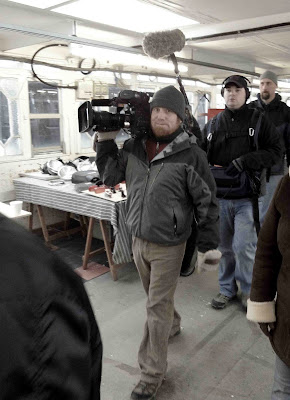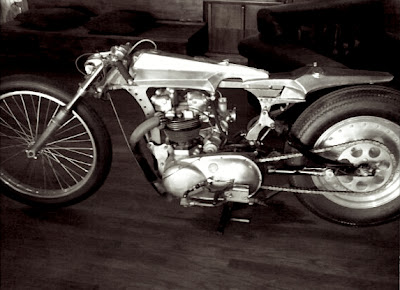I've known about it for years, but heard it was kind of drab, so had never made a point to visit the
London Motorcycle Museum. While being tourguided by
Dai Gibbison through the environs of the capital, he snuck in a stop at the LMM, housed in an old stable and farm buildings in Greenford, just past Heathrow airport.
 |
| Mills-Furford sidecar; a Zeppelin on the side. |
I tend to view small museums as depressing, as they invariably have poor lighting and horrid sightlines to the machines which need a closer look, and feel to me like underfunded zoos, with beautiful creatures locked behind bars. I would have felt the same about the LMM, housing some interesting bikes but nothing amazing, had they not recently opened a new exhibit in a barn out back, which contains a collection entirely of Triumphs...not in itself something to jump for joy, but it turns out the owner of the museum - Bill Crosby- owns
Reg Allen Motorcycles, in business since 1958, and a Triumph agent from 1978-'83. Bill, an inveterate collector of interesting old bikes and memorabilia, has displayed his collection, in various locations, since 1974.
 |
| The och Triumph prototype in Egli frame |
Crosby seems especially fond of Triumph one-offs and prototypes, as several ultra-rare bikes grace the barn, which are worth a look. Two of the three factory-built overhead-camshaft BSA/Triumph triples are inside; one built as a BSA (the original factory tester) the other in a very early
Egli chassis, intended as a racer. While the OHC 'three' was quieter and a little smoother than the normal pushrod engines, with a much less complicated valve operating system using a toothed rubber belt, it was no faster than the original design, and had the fatal flaw of needing the camshaft removed to change the center spark plug! Which could have been cured by making the engine DOUBLE overhead camshaft, but Triumph weren't thinking so far ahead with the 'threes' in 1970... to their detriment. It took
John Bloor to sort that out after buying the defunct Triumph in 1983;
he began making dohc Triumph Triples in 1989.
Triumph did design a dohc twin, the
'Bandit', made in small numbers in 1970 (badged also as the BSA 'Fury' - as seen here in the LMM, one of only 5 to survive), was their attempt to answer the Japanese challenge of high-tech, relatively inexpensive bikes with great performance. The Bandit/Fury was a very attractive design with excellent performance for the day - 34hp/110mph from 350cc - but cash flow problems and stupid mistakes from their drawing office killed the project. The rumor of their failure includes a batch of electric starters which had been designed, and contracted/built by an outside supplier, too short for the engine. It is also claimed by one ex-Triumph employee that the tooling to machine the complicated cylinder heads was rented, and on failure to pay the fee, the owner of the tools confiscated and destroyed them. No government bailouts for cash-strapped manufacturers then...although Triumph got one later, which kept the
Meriden Co-op alive for a few years. Had the British motorcycle industry got the sort of
massive loans afforded to Honda in the 1950s, the story might have turned out differently...but then given the complacency and lack of vision of the English Boards of Directors, perhaps it was best to let the industry die, for we might have seen fast dohc Triumphs which leaked oil and had poor spares backup! Instead, in an ironic twist, the reborn Triumph took lessons from the Japanese.
 |
| Spot the middle cylinder... |
LMM houses the prototype three-cylinder Triumph, the 'P1'
(above), which is actually owned by the
Triumph/BSA Triples Owners Club. The engine, considerably wider and heavier than the Bonneville unit, is shoehorned into a standard Bonneville rolling chassis, which has had its bottom frame rails widened. It takes a sharp eye to spot the extra cylinder in the middle, as the general configuration is so similar to the twin-cylinder design. I can't imagine the prototype handled that well with the extra weight, and when introduced, the BSA Rocket 3 and Triumph Trident shared a new frame which accommodated the engine well, and handled on par with the lighter Twins.
Another prototype machine which I'd never seen before is an Overhead Camshaft single-cylinder Triumph racer from 1929 - Triumph's first attempt at a cam up top (although
Edward Turner had
designed his own ohc single in 1925, and built a prototype in 1927, long before he came to Triumph; he didn't design this machine). The cam drive looks very much like an early
Norton 'CS1' arrangement, with rockers enclosed within a cambox on the cylinder head, the actual rocker arms emerging from the
side of the cambox, meaning fewer oil leaks than the
later Norton 'International' and 'Manx' designs, in which the ends of the rocker arms emerge from a slot above the valves - difficult to seal, and even in 1962 Manxes were merrily squirting cambox oil onto their back tires.
 |
| Triumph OHC racer prototype squeezed 'twixt two Triples |
While tidy and very sporting, it seems the prospect of a complicated assembly procedure for the engine, requiring skilled labor and much time to set up properly, was a deal-breaker for a big company like Triumph, and they dropped the project. If you want to see the bike, here is your only chance...but it would have been nice not to have to crawl over the guard rail and squeeze between other machines to see the engine properly. Well,
you don't have to anyway - here it is:
Bill Crosby's son gave us a private tour of the new barn, and was very enthusiastic about their plans to expand and properly light the exhibit of 50 or so Triumphs. Let's hope they do, as the collection is worth a look.
 |
| The Triumph barn |
 |
| A very rare 1920s Blackburne-engined sprinter... |
 |
| ...and the '60s Triumph version. |
 |
| The original Triumph Thruxton. |
 |
| Seeley Commando and BSA Victor racers. |
 |
| A 'sectioned' Velocette LE engine. |
 |
| Triumphs for days. |

































































